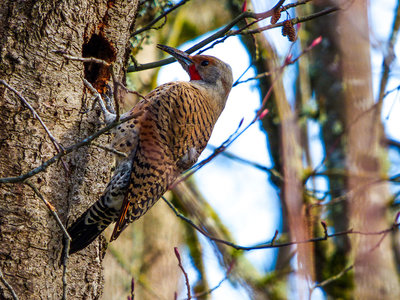
In May, as the sun sets each evening, thousands of small birds swarm above the brown brick chimney of Agate Hall on the University of Oregon campus. They are Vaux’s swifts, newly arrived from Central America. When the light begins to die, the cloud flies together and spins into a funnel above the chimney mouth and the swifts dive down to roost for the night.
Below in the parking lot, a dozen people watch the show, including Maeve Sowles, president of Lane County Audubon Society.
“I had a friend from Hawaii tell me once that if this happened on the islands, there would be tour buses and tickets to this,” says Sowles, originally from Hawaii as well. Right now, the birds are free of charge.
There are few hobbies as convenient as birdwatching, also known as birding, or in England, twitching.
“My daughter calls birding a gateway drug to the natural world,” says Jim Maloney, a photographer and ecologist at the Lane County Audubon.
According to Maloney and other members of the society, birding in Oregon and the U.S. is alive and flapping.
A national survey by the U.S. Forest Service backs him up. In 2013, some 85 million Americans spent time observing, photographing or feeding wild birds. About 18 million people made special trips in 2011 to see or count birds by sight or sound.
“If you’re outside, then you can be birdwatching,” Sowles says. “It allows us to be closer to a non-human part of the world, and adds another dimension to enjoying the outdoors.”
At the society’s early May meeting, members discussed education efforts in local schools and conservation issues around the county. Talk veered occasionally into stories about crows chasing eagles or suspicious turkey activity around Spencer Butte.
Birding is auditory as well as visual for keen observers. An eagle can be detected, and even identified, as much by its cry as its feathers. Migration patterns mean new species arrive and depart year round and, like every good hobby, there’s always a new challenge awaiting.
The National Audubon Society, a registered nonprofit, began in 1905 after a growing outcry against bird slaughter for fashion or development. Conservation, education and grassroots organizing became their main tools.
The branch in Lane County began as the Oakridge Audubon Society during the late ’60s. In 1975, it expanded into a countywide organization and, in addition to local outreach, now helps traveling birders find rare and uncommon fowl.
Vaux’s swift is one of those birds. These swifts, which migrate between Central America and Canada every year, remain in flight constantly except when resting. Their natural roosts are enormous tree snags, now scarce because of logging, though chimneys are an attractive, urban alternative.
Sowles emphasizes that Lane Audubon loves to encourage birding, but education and conservation are their real missions.
“We’re very fortunate to have a well-preserved environment in Lane County,” Sowles says. “You can still see what it was like 200 years ago.”
However, the ecosystem is changing. “Winter temperatures are higher now, and we have birds that we’ve never had before in the Willamette staying here all the time,” she says, like black phoebes. Others — like the Western meadowlark, Oregon’s state bird — are now rare.
Lane Audubon, which claims about 1,600 members, recommends beginners or interested parties join its monthly bird walk. They organize a walk every third Saturday of the month and provide knowledgeable guides. Binoculars can be loaned upon request.
The next Audubon walk is 8 am Saturday, June 20. Birders meet at the South Eugene High School parking lot for carpooling.
Armchair birdwatchers can follow the adventures of local birder Noah Stryker as he travels around the world trying to document 5,000 species for his Big Year at audubon.org/features/birding-without-borders.